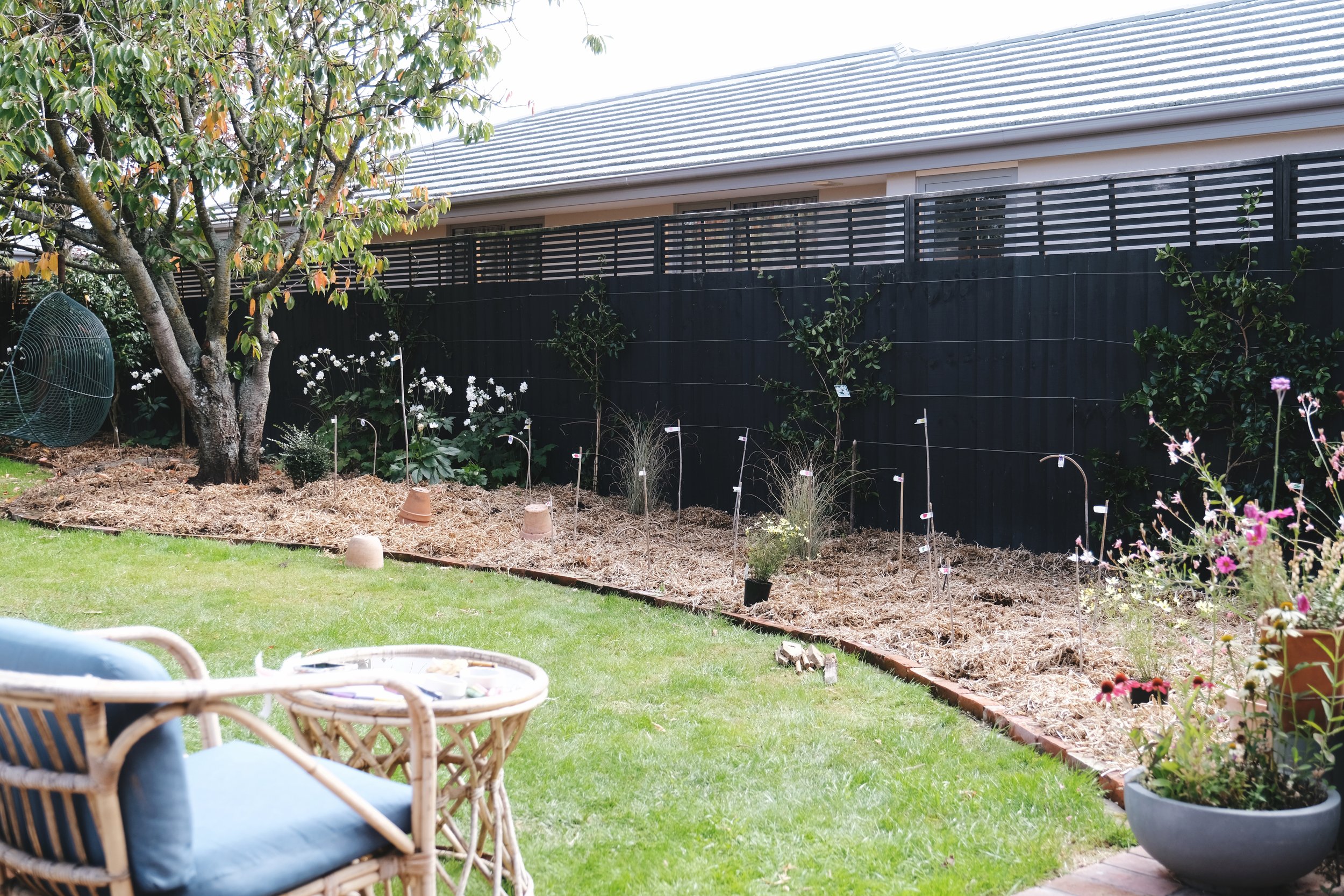A Garden in Progress - Part One
/I have been alluding to my ambitious garden changes since last autumn and thought that revealing the progress made-to-date, might help me see that I am getting there! In this jerky process I’ve come to realise that most gardens are “half” gardens, always morphing into more in the minds of their creators, even if not in the physical sense yet.
My first admission must be that, I have cut down no less than nine trees in my small urban garden. I can almost feel the ripple of displeasure, however five years of observance taught me what was working and what was only going to get disastrously bigger. It seems most trees are planted with disregard to their eventual size.
BEFORE: Summer 2020
AFTER: A garden in progress in autumn 2022
There was the old plum, incredibly productive despite its diseased state, however, after years of defending its life for the great aesthetic whimsy it gave the garden, the annual onslaught of sludgy, not-delicious-at-all fruit bought its downfall. There was the enormous cabbage tree with heavy heads atop two distinct trunks, growing out on angles. Aside from the non-compostable leaves it aggressively threatened to take out the fence, and our neighbours living room. I couldn’t sleep a wink from worry if it was windy and indeed, on its removal, we realised just how close to disaster we had been.
There were the feijoas which had been planted too densely but trudged along producing a bounty that we simply didn’t like (yes, we are of the 50% who don’t like feijoas) and the beech tree that hated its crammed position and was destined for mammoth growth. Then, there were the satin woods that were doing a great job of blocking the neighbour’s windows. The problem was, they did a terrific job of blocking sunlight too. I squirmed as visiting tree expert Chris Walsh of Tree Tech suggested all sorts of ways I could trim but retain them, but couldn’t beat the potential of this new clear space. The potential won.
The result has been an influx of light into our garden, allowing existing trees to relax and thrive without the competition and force me to rethink ways to regain the privacy of both us, and those right next door.
The horror of this cabbage tree! I felt so relieved when it was removed yikes!
Very sad, but the old plum was significantly diseased.
Tree Tech were total professionals!
T digging in a brick mowing edge, tracing the hose lines created by Penny Zino and substantially increasing garden space.
While I had considered creating a curb out from the fence, it was Penny’s idea to reflect its shape with a “half moon” from the concrete pad of the studio. This then led to the idea of the raised planter behind it.
After a visit from my mentor Penny Zino, armed with a hose and plenty of ideas to build on my own, we mapped out expanded garden borders, inhaling lawn and creating soft fluid lines as a departure from straight, fence bordered beds. Penny’s hose lay on the lawn for months as I threatened violence to anyone who’d move it, then, in the second lock down, my husband T, dug in and traced the lines with brick to act as a new mowing edge, finally giving us an impression of what we were heading for.
Despite my keenness, I’ve felt paralysed at times to take “the next step”. As it turns out, each has been forced upon me as T has had time to execute the “hard scaping”. A last-minute disruption in his work schedule allowed T and his workmate build a long, raised brick planter. I was plunged into urgent decision making as progress was made, deciding on the final planter height in real time and urgently researching local soil suppliers that would provide a quality mix. I’m under no illusions that I’m spoilt with the help and grateful that someone in the house was keeping the show on the road!
T and Ernie using a spare work day to make my dreams come true! They have worked together as bricklayers for over 30 years!
The reclaimed bricks were left over from a project at my sisters place. They had been lucky enough to have been given them! Secondhand bricks are valuable if you can ever take some of someone’s hands.
And there is never any mucking around. Progress happens quickly!
The new planter injected me with enthusiasm and I invested in an online course by UK gardening dynamo Dan Pearson to help guide my ideas. A full notebook of plant names for research and a million rough sketches quickly followed.
In a flurry of progress, we weeded existing beds, sprayed lawn (there are alternatives to spraying of course, and had this been a vegetable garden I would have chosen them!), trailered in quality soil mixes to help a few spots along and chewed through six bales of pea straw to create beautiful beds ready for planting. The result was a rather agricultural smelling clean slate!
Planting wise, I am creeping forward. The original urgency of having all this done for last spring has relented to an understanding that good things take time. With such a wet summer, I have been able to buy and transplant as I come by the specimens I am after. My own young plants are ready for the ground, as are those that I have kindly been given by gardening friends, kept watered in their containers under the trees.
Potted Miscanthus sinensis ‘Morning Light’ from Southern Woods Nursery getting shifted around in my “testing”. These grasses grow very large over time, so I will gradually chip away and divide them for another project I have coming up.
We then used additional bricks, layed on their side behind the mowing edge to create a slightly raised retainer for the beds.
Pea straw nearly all on and additional 3 x Camellia sasanqua planted along the fence in addition to the two that were existing. These will gradually grow and allow me to train them both along and up to the top of the trellis, screening our neighbours nicely.
I’ve spent much time studying naturalistic gardens and the ideas around a wild, seasonally interesting concept. Taking inspiration from my existing raised bed full of airy perennials, I have crossed checked species I already love for their hardiness, seeding behaviour and water needs. After so many garden visits and quizzing of experts, it has become my aim to create planting combinations that are resilient and require minimal additional water.
I mean, I live in hope!
As I write this, I look out the window at my progress. Bamboo stakes with colour coded tape dot the pea straw beds in reference to my scribbled notebook plan, indicating little gatherings of perennials. 10 Miscanthus sinensis ‘Morning Light’ have taken up residence, promising movement and structure in my imagined ethereal planting. They will grow enormously, but will divide regularly to sell and use (on another secret project).
I have taken the plunge and transplanted round topiary balls sporadically at the brick edge for winter interest, even breaking one “out” to perch on the lawn. Two sad espaliered camellias that had been hiding behind the fejoas, have been tidied up and joined by another three of the sasanqua variety, reaching their fingers high and wide in my pursuit of an evergreen fence and promised privacy. A special spot awaits the arrival of a Cornus ‘Greenvale” (Dogwood) which will add to my urban seclusion.
My bulb order of daffodils and Dutch irises will be squeezed between the perennial planting, intended to deliver a low, fresh spring palette preceding the planned seasonal morph into a warm and airy one come next summer.
Colour coded stakes help me map out my plant mixes. They aren’t showing individual plants, more the areas that I will cluster seedlings of the indicated plant types. Heights of the stakes aren’t true to the plants either! Just what I had at hand.
Two existing box balls and a purchased (smaller) “poor mans box” Lonicera nitida which is faster growing and cheaper to buy! I purchased mine from Plantz.
The idea to “bust” one out of the edging and onto the lawn was in an effort to keep things informal and a little playful. The addition of topiary is an effort to provide interest and structure in winter and spring while plants are bolstering up.
The true release, and perhaps permission I needed to riff on the new perennial movement in my own way, was the conversations I have had with gardeners I respect. While each have readily answered my questions, they always seem to stop short at final advice, encouraging me to do what I want in the understanding that a garden is a personal reflection rather than a concrete imitation. Amen!
This is an expanded version of the article featured in my Stuff ‘Homed’ gardening column for beginners , The Press, Dominion Post and other regional papers on March 17 2022
All words and images are my own, taken in my home and garden in Christchurch, New Zealand unless otherwise captioned.

















